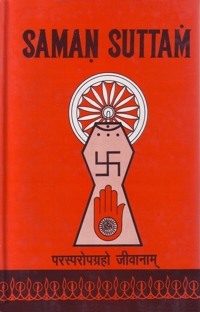17. Ratnatraya Sutra
PRECEPTS ON THREE JEWELS
(A) VYAVAHARA-RATNATRAYA
The three jewels understood from the stand-point of vyavahara-naya (practical view-point).
Dhammadisaddahanam, sammattam nanamangapuvvagadam.
Cittha tavamsi cariyha, vavaharo mokkhamaggo tti. (209)To have faith in the existence of (substances like) dharma etc. is right faith, to have acquaintance with the texts called Anga and Purva is right knowledge, to perserve in the performance of penance is right conduct. These three constitute the pathway-to-emancipation understood from the standpoint vyavahara-naya. (208)
Nanena janai bhave, damsanena ya saddahe.
Carittena niginhai, tavena parisujjhai. (209)One understands by his (right) knowledge the nature of substances, develops belief in them by his (right) faith and controls himself by his (right) conduct and purifies his soul by penance (i.e., austerities). (209)
Nanam carittahinam, limgaggahanam ca damsanvihinam.
Samjamahinam ca tavam, jo carai niratthayam tassa. (210)Knowledge without right conduct, acceptance of the asceticism without right faith and observance of austerities without self-control are all futile. (210)
Nadamsanissa nanam, nanena vina na humti caranaguna.
Agunissa natthi mokkho, natthi amokkhassa nivvanam. (211)Without right faith, there cannot be right knowledge; without right knowledge, there cannot be right conduct; without right conduct, there cannot be release from Karmas; without release of Karmas there cannot be nirvana (salvation). (211)
Hayam nanam kiyahinam, haya annanao kiya.
Pasamto pamgulo daddho, dhavamano ya andhao. (212)Right knowledge is of no use in the absence of right conduct, action is of no use in the absence of right knowledge. Certainly, in the case of conflagration the lame man burns down even if capable of seeing while the blind man burns down even if capable of running away. (212)
Samjoasiddhii phalam vayanti, na jhu egacakkena raho paydi.
Andho ya pamgu ya vane samicca, te sampautta nagaram pavittha. (213)The desired result is attained when there is a harmony between right knowledge and right conduct, for a chariot does not move by one wheel. This is like a lame man and a blind man come together in a forest and manage to reach the town with the help of one another. (213)
(B) NISCAYA-RATNATRAYA
The three jewels understood from the standpoint of niscaya-naya (real view-point.)
Sammaddamsanananam, eso lahadi tti navari vavadesam.
Savvanayapakkharahido, bhanido jo so samayasaro. (214)The self is characterised by right faith and right knowledge is merely an assertion (by vyavaharanaya). In reality what transcends all points of view is said to be the Self (Samayasara) (214)
Damsanananacarittani, sevidavvani sahuna niccam.
Tani puna jana tinni vi, appanam ceva nicchayado. (215)From practical point of view faith, knowledge and conduct should always be cherished by saints. But they must know that from real point of view these three are the self. (215)
Nicchayanayena bhanido, tihi tehim samahido hu jo appa.
Na kunadi kimci vi annam, na muyadi so mokkhamaggo tti. (216)It is said from the real point of view that, the soul who comprises all the three together; and does not act otherwise or depart from this even in the slightest degree, follows the path of Liberation. (216)
Appa appammi rao, sammaitthi havei phudu jivo.
Janai tam sannanam, caradiha carittamaggo tti. (217)Right faith means a soul engrossed in itself; Right knowledge is knowledge of the real (nature of) the sould; Right conduct consists in faithful pursuit of that path. (217)
Aya hu maham nane, aya me damsane caritte ya.
Aya paccakkhane, aya me samjame joge. (218)Certainly, my soul is my right knowledge, my right faith, my right conduct, my renunciation of evil acts, my self-restraint and my meditation. (218)
 Jinendra Varni
Jinendra Varni

